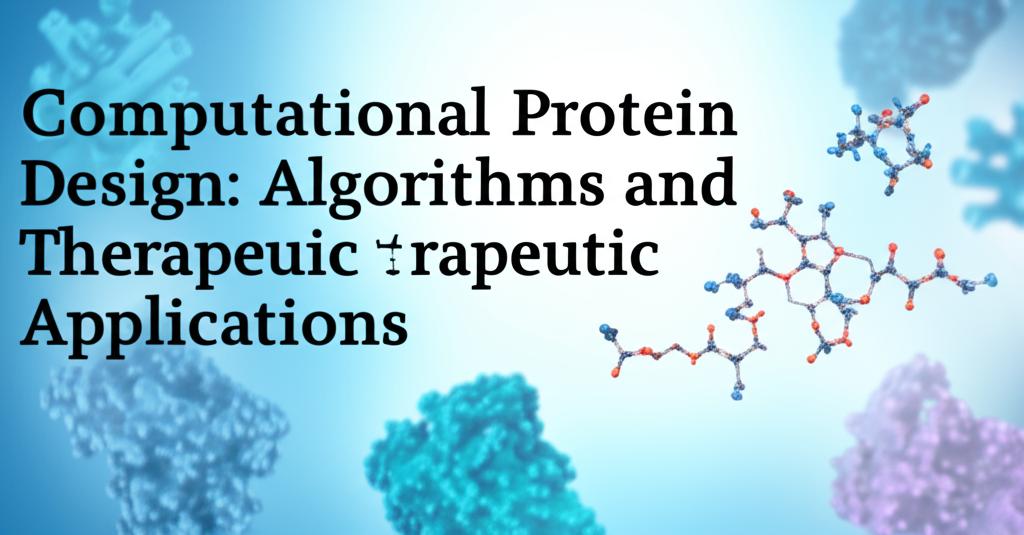Computational protein design is a rapidly evolving field that is transforming drug development and biotechnology. It involves using computer algorithms to create new proteins with specific structures and functions, or to optimize existing ones. This approach moves beyond discovering and modifying naturally occurring proteins to engineering entirely new molecules tailored for therapeutic purposes.
Key Algorithmic Advances and Their Impact:The engine driving this revolution is artificial intelligence (AI), particularly machine learning and deep learning. These sophisticated algorithms are making protein design faster, more precise, and capable of tackling challenges previously out of reach.
- Structure Prediction and De Novo Design: Tools like AlphaFold, developed by Google's DeepMind, have achieved remarkable accuracy in predicting the 3D structure of proteins from their amino acid sequences. This has been a game-changer for understanding existing proteins. Going a step further, algorithms like Rosetta, pioneered by David Baker's lab, and newer AI-powered tools like RFDiffusion, enable de novo protein design – the creation of entirely new protein structures from scratch. RFDiffusion, for instance, uses diffusion models, analogous to how AI image generators create images, to generate novel protein architectures. The 2024 Nobel Prize in Chemistry recognized the profound impact of AlphaFold and computational protein design, highlighting their transformative potential.
- Generative AI and Deep Learning: Deep learning models are increasingly used for various design tasks, including inverse folding (designing a sequence for a given backbone structure), antibody design, and peptide design. Generative models, including diffusion models and flow-based models, are showing significant promise in generating diverse and functional protein structures.
- Integrating AI with Experimental Methods: An "AI-lab loop" approach, which combines computational design with experimental validation, is becoming crucial. This iterative process allows for rapid refinement and optimization of designed proteins.
- Accessibility and New Platforms: Emerging platforms like Copilot by 310.ai and DeepSeq.AI are making advanced protein design tools more accessible to researchers without specialized computational expertise. Some platforms even allow users to specify design goals using natural language.
The ability to design proteins with high precision has opened up numerous therapeutic avenues:
- Novel Drug Candidates: Computational design is accelerating the discovery of new drugs. AI-designed drugs, both small molecules and biologics, are already in clinical trials. For example, INS018_055 is an AI-designed anti-fibrotic small molecule inhibitor in Phase II trials, and GB-0669 is an AI-designed monoclonal antibody against SARS-CoV-2 in Phase I, notable for targeting a previously considered "undruggable" region.
- Therapeutic Antibodies: A significant breakthrough has been the de novo design of antibodies with therapeutic-grade properties without needing extensive experimental optimization. Systems like JAM (Joint Atomic Modeling) have designed antibodies with high affinity for multiple targets, including challenging ones like multipass membrane proteins (e.g., Claudin-4 and CXCR7). This could unlock new therapeutic modalities for historically difficult targets.
- Vaccines and Antivirals: AI models were rapidly deployed during the COVID-19 pandemic to design antiviral proteins targeting SARS-CoV-2, demonstrating the speed at which these tools can respond to emerging health threats. De novo designed proteins are also being explored for vaccines.
- Enzyme Engineering: Computational methods are being used to design and optimize enzymes for various applications, including "green chemistry" and therapeutics. Specialized software can identify distal mutation sites for enzyme engineering.
- Targeting Immune Deficiencies and Cancer: Researchers are using computational design to create protein variants with improved therapeutic properties. For example, designs based on the protein hormone G-CSF (involved in blood formation) show potential for treating neutropenia and could lead to orally available treatments for immune diseases and cancer. In CAR-T cell therapy, computational design is being used to create "logic gates" by combining multiple antigen binders, aiming to increase the specificity of engineered cells for tumors.
- D-peptide Inhibitors: Algorithms like DexDesign are enabling the creation of D-peptide inhibitors. These are particularly promising for therapeutics because they are resistant to degradation by enzymes in the body, potentially leading to more stable and effective drugs.
- Addressing Protein Stability and Delivery: A major challenge in biologic drug development is ensuring stability, deliverability, and minimizing immunogenicity. Computational design tools are being used to address these issues from the outset, creating more robust and effective therapeutic proteins.
- Designing for Noncanonical Amino Acids: Computational design is expanding to include noncanonical amino acids (those not among the standard 20). This opens up possibilities for creating proteins with novel chemistries and properties, although it remains a challenging area, especially for machine learning due to data scarcity.
Despite remarkable progress, challenges remain. Improving the accuracy of biophysical models and algorithms is crucial for increasing success rates. The gap between computational design and experimental realization, while narrowing, still exists. Ensuring transparency, reproducibility, and establishing clear regulatory pathways for AI-designed therapeutics are also important considerations for the field's future.
Nevertheless, computational protein design, particularly driven by AI, represents a paradigm shift in drug discovery and biotechnology. It is moving beyond mimicking nature to actively programming biology, paving the way for a new era of rationally designed medicines and an expanding repertoire of therapeutic possibilities to tackle complex diseases. The continued development of more powerful algorithms, combined with rigorous experimental validation, promises to further accelerate innovation in this exciting field.

